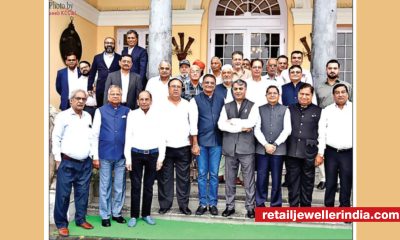Daily News
Vummidi Bangaru Jewellers crafts 147-kg golden ‘Sriramcharitmanas’ ahead of Ram Navami on April 17

Each meticulously crafted gold-plated page, with a thickness of 1 mm, shows great attention to detail. Creation of this masterpiece involved a number of design processes, right from precise CorelDraw 2D drawings to sampling the pages, and it will be placed in the sanctum sanctorum of the Ram Mandir at Ayodhya
Chennai: Vummidi Bangaru Jewellers (VBJ), which designed and made the historical sceptre or Sengol installed in the new Parliament House, has now crafted the epic ‘Sriramcharitmanas’ in gold. The artefact will be placed in the Garbhagriha or sanctum sanctorum of the newly inaugurated Ram Mandir in Ayodhya on Ram Navami, which falls on April 17.
The golden epic, displayed at VBJ, weighs 147 kg overall, with 522 gold-plated pages. All pages of the ‘Sriramcharitmanas’ narrate the timeless chronicles of Lord Rama, woven with poetic eloquence and spiritual depth.
The stand to place the book in the Ayodhya temple has also been designed by VBJ, with the right technicality and practicality to hold its weight. The entire process took around eight months to craft and deliver, a press release said.
Sriramcharitmanas is divided into six ‘kandas’ or chapters, each encapsulating a distinct phase of Lord Rama’s divine journey. They are the Bala Kanda, Ayodhya Kanda, Aranya Kanda, Kishkindha Kanda, Sundara Kanda and the Uttara Kanda.
Each page, with a thickness of 1 mm, shows intricate attention to detail and craftsmanship. Creating this masterpiece involved a number of design processes, right from precise CorelDraw 2D drawings to sampling the pages.
The text of the epic poem, with its unique characters, required a set of skilled artisans to ensure that each word was clearly and accurately etched onto the surface of the gold pages. Additionally, etching the poem on both sides of the sheet posed a challenge, demanding perfect alignment and coordination to ensure that the text remained coherent and legible from every angle.
The process involved utilizing a cutting-edge printing technology known as UV (ultraviolet) printing to reproduce the imagery of each sacred scene onto the surface of the gold metal sheets, adding vibrant colours to the depictions. It was used especially on the front page, which is Ramapattabhishekam, and for the picture of Lord Hanuman right before the Sundara Kanda chapter.
A couple of pages like the RamCharan with SitaCharan and the Ayodhya Temple involve a delicate balance of two-tone metals, seamlessly blending gold and silver hues, and highlight the meticulous artistry and technical expertise involved in harmonizing these contrasting elements.
Courtesy: thehindubusinessline.com

 Personal Opinion2 weeks ago
Personal Opinion2 weeks agoBuy-back on gemstones to be on par with gold; A fear of return on the investment, more among high-end clients: Ankur Anand, Harsahaimal Shiamalal Jewellers

 Maverick Greenhorn1 month ago
Maverick Greenhorn1 month agoSegmenting retail approach to boost business performance

 Exclusive4 weeks ago
Exclusive4 weeks agoPrasad Jewellers’ Gold Bar Challenge fulfils multi-channel engagement goals, attracts young customers

 Daily News2 weeks ago
Daily News2 weeks agoTBZ – The Original launches its first store in Jaipur































